Cleaning and sanitizing all you home brew equipment is the one thing you can do to guarantee your beer doesn’t spoil. If you fail to adequately clean and sanitize your equipment, you have a good chance of ruining your beer—which has been known to make grown men and women cry. Thankfully, cleaning and sanitizing is pretty damn easy. It just takes some attention to detail and a little common-sense. If you can wash and scrub dishes, you’ll have no problems keeping your equipment clean. It simply involves soaking, rinsing, or spraying your equipment before it touches the beer. So, let’s get to it!
Always start with a good cleaning
First, before you do any sanitizing, you need to clean your equipment. You can’t have one without the other. It just takes one piece of dirt stuck at at the bottom of the carboy that you didn’t spot and no sanitizer in the world can guarantee that the speck of dirt won’t unleash unwanted bacteria into your precious beer. It simply cannot remove built-up grime that harbour bacteria in the same way a cleaner can.
Get a good cleaning agent
I wouldn’t skimp out on a cleaning agents—get only the best. And the best is either PBW (Powdered Brewing Wash) or Oxiclean. Oxiclean is widely available anywhere, but PWB is even stronger. Both will do just fine.
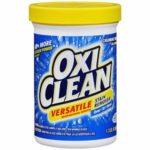 OxiClean is worth it. This cleaning agent is very effective, and can even be used to remove beer labels if you’re collecting bottles from breweries. It’s pretty damn cheap and highly effective. If you can, try to buy the Versatile free version.
OxiClean is worth it. This cleaning agent is very effective, and can even be used to remove beer labels if you’re collecting bottles from breweries. It’s pretty damn cheap and highly effective. If you can, try to buy the Versatile free version.
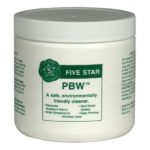
PBW is the best, but it’s expensive Another oxygen-based cleaner, it’s the best one on the market, but it’s also priced accordingly. Oxiclean is (almost) as good, so if you’re price sensitive, use Oxiclean. It’s obviously not as accessible as Oxiclean, but if you’re already buying all your ingredients and equipment at a homebrew shop, they’ll carry it.
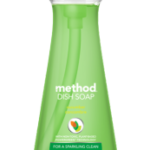 Can I use dish soap? Technically, yes, you can. It happens to be cheap and already in your kitchen. But if you use it, you must rinse it thoroughly. Otherwise it will taint your beer with a soapy taste and kill head retention in the final product. If you want to use dish soap, do yourself a favour and get a perfume-free variety. My best advice, however, is to get oxiclean or PBW.
Can I use dish soap? Technically, yes, you can. It happens to be cheap and already in your kitchen. But if you use it, you must rinse it thoroughly. Otherwise it will taint your beer with a soapy taste and kill head retention in the final product. If you want to use dish soap, do yourself a favour and get a perfume-free variety. My best advice, however, is to get oxiclean or PBW.
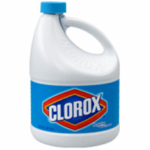 What about bleach? Believe it or not, you can use bleach. It’s what homebrewers used for ages. But honestly, I wouldn’t bother with it. You have to rinse it like a paranoid son of a gun. Even the smallest amount could ruin your entire batch of beer. Plus, it could ruin your clothes, stain your bartowels and bring back horrible childhood memories of swimming classes. Just don’t bother. It’s not worth it, I tell ya!
What about bleach? Believe it or not, you can use bleach. It’s what homebrewers used for ages. But honestly, I wouldn’t bother with it. You have to rinse it like a paranoid son of a gun. Even the smallest amount could ruin your entire batch of beer. Plus, it could ruin your clothes, stain your bartowels and bring back horrible childhood memories of swimming classes. Just don’t bother. It’s not worth it, I tell ya!
Then clean everything that will touch your beer
You’re going to need to clean the following items on brew day…
- Fermenter (carboy)
- Airlock
- Funnel
- Fine Mesh Colander
- Thermometer
- Big Spoon
…and the following items on bottling day…
- Hoses
- Auto-siphon/racking cane
- Bottling Bucket
- Bottles
- Anything else that touches your beer
Learn from me. For longer than I’d like to admit, I thought I could get away by just hosing down my gear, (wrongly) thinking that so long as I sanitized my gear, I’d be alright. I was wrong. Quite wrong. And I’ve had too many spoiled batches as a result. After too many failed batches, I took the cleaning part much more seriously and did a lot of homework to find out what I was doing wrong. One of them was not using a proper cleaning agent; the other was not giving all my gear a good cleaning. Do not assume your gear is clean until you’ve soaked it properly in a cleaning agent.
In truth, I likely became complacent because my first three batches were near perfect. I had the false impression that I was doing everything right on the cleaning/sanitizing front. Then, two of my next three batches were spoiled because of cleaning issues. If you’re a new brewer and think you’ve done it alright, I encourage you to at least keep reading this. The more you brew, the more grime build up your beer will potentially have. When our gear is completely new, it requires a lot less cleaning (by luck). So do yourself a huge favour, don’t skip this part.
Soak for 20 minutes
Soak your equipment for 20 minutes (or longer if needed) in your preferred cleaning solution, then scrub lightly to get rid of any residue and dirt. Obviously you can’t scrub hoses, airlocks, racking canes etc, but the 20-minute soak alone should do the trick. If you spot any residue that refuses to dislodge after a good soak, you should just replace the gear. I personally replace my hoses after 10 batches, just to be safe. If you want to give that piece of gear one final chance to redeem itself, try a 24-hour soak. But after that, take it out of its misery if it hasn’t improved.
A quick note here: Do not use an abrasive sponge or brush when cleaning any plastic. Use a soft-cloth towel or a soft sponge instead. Scratches in plastic equipment are ground zero for bacteria. I’d even be careful with your stainless steel pot—if the brush is too abrasive, it could scratch the surface. Stick to softer sponges if you can.
Always sanitize after cleaning
Once your gear is clean, it’s time to sanitize any and all items that will come in contact with the wort after the boil.
On brew day…
- Fermentor (carboy)
- Airlock
- Airlock stopper
- Thermometer
- Funnel
- Yeast packaging
- Scissors (if using dry yeast)
On bottling day…
- Bottles
- Bottling bucket
- Auto-siphon
- Hoses
- Bottle-caps
Get a good sanitizing agent
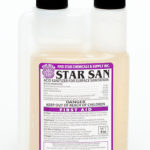 I highly recommend using StarSan. StarSan is definitely the most popular sanitizer, and is used by the pros. Not only is it flavourless, odourless and requires no rinsing, it foams easily. And that’s a good thing. The foaming action gets the sanitizer into all the possible cracks and crevices, finding and killing any unwanted microorganisms. But as with all good things, use in moderation. Too much foam and you’ll find things get a little unruly. But even so, it’s flavourless, so if you find yourself with equipment sporting a little too much foam, relax, it won’t ruin the taste of your beer. As many home brewers say, don’t fear the foam! I always keep a spray bottle of StarSan solution, which is good so long the solution remains clear. (If it gets cloudy, it means the pH levels have changed and its lost its effectiveness). A spray bottle is such a convenience and makes sanitizing in a pinch easy.
I highly recommend using StarSan. StarSan is definitely the most popular sanitizer, and is used by the pros. Not only is it flavourless, odourless and requires no rinsing, it foams easily. And that’s a good thing. The foaming action gets the sanitizer into all the possible cracks and crevices, finding and killing any unwanted microorganisms. But as with all good things, use in moderation. Too much foam and you’ll find things get a little unruly. But even so, it’s flavourless, so if you find yourself with equipment sporting a little too much foam, relax, it won’t ruin the taste of your beer. As many home brewers say, don’t fear the foam! I always keep a spray bottle of StarSan solution, which is good so long the solution remains clear. (If it gets cloudy, it means the pH levels have changed and its lost its effectiveness). A spray bottle is such a convenience and makes sanitizing in a pinch easy.
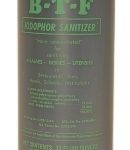 You could also use Iodophor, an iodine-based sanitizing solution available online and in most homebrew shops. It’s also a no-rinse sanitizer that requires very little contact time. But it will stain plastic equipment over time and could leave a funny odour if you accidentally use to much.
You could also use Iodophor, an iodine-based sanitizing solution available online and in most homebrew shops. It’s also a no-rinse sanitizer that requires very little contact time. But it will stain plastic equipment over time and could leave a funny odour if you accidentally use to much.
Soak what you can, spray what you can’t
I usually fill up my bottling bucket with sanitizer solution (1/4oz StarSan for 1.25 gallons water) and toss in all the gear that needs sanitizing. Your gear only needs one minute of contact time with the sanitizer solution, and it’s good to go. For the more awkward items, I use a spray bottle filled with sanitizer solution to spray the gear thoroughly. Wait a minute, and you’re good to use it.


Leave a Reply